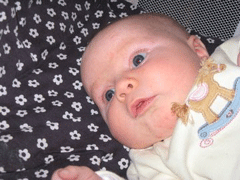Pesticides and Birth Defects
Air Date: Week of April 17, 2009

In the spring and early summer, levels of pesticides in water increase. One weed killer in particular, Atrazine, shows up in surprisingly high amounts. Host Steve Curwood talks with Dr. Paul Winchester to learn why babies conceived between April and July may be more likely to develop birth defects.
Transcript
CURWOOD: From the Jennifer and Ted Stanley Studios in Somerville, Massachusetts - this is Living on Earth. I’m Steve Curwood.
YOUNG: And I’m Jeff Young in Washington.
When crops go in the ground and start to grow, it’s the time for conventional farmers to apply chemical weed killers.
For example, millions of pounds of Atrazine are applied on US farms each year, even though the herbicide is banned in Europe.
And it should not be surprising that between April and July, there tend to be higher levels of pesticides in water than during the rest of the year, as the U.S. Geological Survey has found.
CURWOOD: What is surprising is new research that shows an association between the time of conception, pesticide levels, and the likelihood of crippling or fatal birth defects.
The research is being led by Paul Winchester, a neonatologist. His curiosity was aroused when he encountered a high level of birth defects when he began working in the heart of farm country at St. Francis Hospital in Indianapolis.
Dr. Winchester, what exactly did you find?
WINCHESTER: We found that birth defects like spina bifida, cleft pallet and lip, down syndrome, urogenital abnormalities, club foot among others are some of the birth defects that are more likely to occur for women who conceive between April and July. That time period coincides quite well with the time period when surface waters measured across the U.S. are having significantly more pesticides in their concentration than any other times of year.
CURWOOD: As a neonatologist, you must be seeing some of these children who have quite extensive urogenital defects. How true is that of your practice?

Dr. Paul Winchester.
CURWOOD: And how much of that are you seeing?
WINCHESTER: Well we do see a lot of it. Probably the most striking things that’s happened to us this last month, which is the month when babies conceived in June are delivering is that it seems that we have seen kind of one of everything. We’ve seen in a small hospital, community hospital setting, we’ve seen major birth defects that range from chromosome anomalies, spina bifida, adactyly, cleft pallet and lip – we’re just struck by the fact that this research appears to be right on, this month.
CURWOOD: How much did this research cost you and how did you pay for it?
WINCHESTER: Well we’re a non-funded research program. I kinda grew up on a farm in Montana where when you see the fences broke you just grab a fence post and a pair of pliers and go and fix it. And you hope that if you’re over there the neighbors will notice and give you a hand. And pretty much that’s how this research has been done. And I sometimes wonder if I had been funded whether this question would have been asked.
CURWOOD: Which question is that?
WINCHESTER: That is the number one cause of infant deaths turns out to have a higher risk occurrence in women who conceive between April and July. I kind of wonder why that’s news. And so, in a sense, we like to ask this large question, because we now know some things in rats and amphibians and alligators that these pesticides are in fact changing them because of fetal exposure. And we don’t have enough time to sort this out before perhaps we could have harmed generations of children.
CURWOOD: Now you say we need to look at the down stream effects of pesticide exposure – what do you mean exactly by that?
WINCHESTER: Probably one of the most important investigators in this area is a man named Michael Skinner who has shown us that the capacity that pesticides have to alter our lives has been grossly underestimated. In his model a pregnant rat is exposed for just a brief period in the very first phase of pregnancy to one pesticide. Keep in mind that there are no children in America who are exposed to just one pesticide. The average child is exposed to 300 chemicals at the time of conception. But in his model with just one pesticide all the rat babies when they were born did not have any birth defects at all. They looked perfectly normal. That’s really important to think about because had the experiment ended there, it would have been declared a safe exposure, not associated with any harm. As he likes to point out, thanks to some inquiring minds he was allowed to keep his experiment going long enough to see how these rats turned out as adults. And there he found that ninety percent of the males were afflicted by a whole host of disorders that we would refer to as adult disorders, adult diseases. They included conditions like low sperm count and infertility, immune disorders, kidney and prostate problems, cancer, high cholesterol and a shortened life span. And if that sounds bad, it’s really not as bad as the rest of the experiment. Because the rest of the experiment showed that this condition could be transferred to all subsequent generations without any further exposure. So if one pesticide could do this, imagine what might be happening in our society.
CURWOOD: What do you tell your patients, people who are thinking about having children, what about conceiving during the beginning of the growing season, this April to July period that seems to increase the risk of birth defects?

CURWOOD: Dr. Paul Winchester is a neonatologist at St. Francis Hospital in Indianapolis. Thank you so much, sir
WINCHESTER: Thank you.
Living on Earth wants to hear from you!
Living on Earth
62 Calef Highway, Suite 212
Lee, NH 03861
Telephone: 617-287-4121
E-mail: comments@loe.org
Newsletter [Click here]
Donate to Living on Earth!
Living on Earth is an independent media program and relies entirely on contributions from listeners and institutions supporting public service. Please donate now to preserve an independent environmental voice.
NewsletterLiving on Earth offers a weekly delivery of the show's rundown to your mailbox. Sign up for our newsletter today!
 Sailors For The Sea: Be the change you want to sea.
Sailors For The Sea: Be the change you want to sea.
 The Grantham Foundation for the Protection of the Environment: Committed to protecting and improving the health of the global environment.
The Grantham Foundation for the Protection of the Environment: Committed to protecting and improving the health of the global environment.
 Contribute to Living on Earth and receive, as our gift to you, an archival print of one of Mark Seth Lender's extraordinary wildlife photographs. Follow the link to see Mark's current collection of photographs.
Contribute to Living on Earth and receive, as our gift to you, an archival print of one of Mark Seth Lender's extraordinary wildlife photographs. Follow the link to see Mark's current collection of photographs.
 Buy a signed copy of Mark Seth Lender's book Smeagull the Seagull & support Living on Earth
Buy a signed copy of Mark Seth Lender's book Smeagull the Seagull & support Living on Earth

